Preventing Moisture During The Winter
Winter cold temperature is usually not a problem for bees, as their muscles will generate heat and keep the cluster warm. The warm moist air produced by the bees trapped in the hive, however, is a problem. If allowed to condense, the warm moist air becomes a cold rain of water down onto the cluster, which will quickly become the cause of winter losses.
One common trick to reducing moisture in the hive is to place a popsicle stick or paint stirring stick on top of the inner cover towards the front of the hive so that the telescoping cover is propped up in the front.
This allows the warm moist air inside the hive a way out and should any build up and condense under the cover, because its raised higher in the front and lower in the back, any condensation would roll to the back of the cover and drip out behind the hive.
I happen to have a few beer bottle tops laying around, and liked the idea of gently pressing their rigid edge down into the wood causing them not to move, so I used them instead.
Another trick that's used to reduce moisture in the hive is to take 1/2 inch (or 3/4 inch) rigid insulation foam board and insulate the inner cover. The idea is that by insulating the inner cover, and preventing the cold winter air getting to the inner cover, warm air will not condense on the bottom side of it and rain down on the bees.
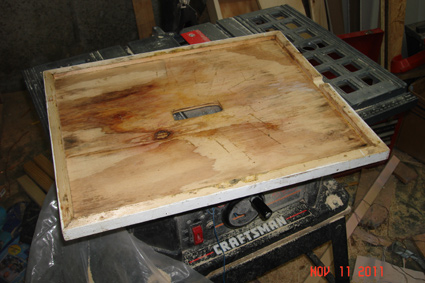
Most hardware stores sell this rigid foam in 4'x8' sections, most for as little as $13 a sheet. Take your inner cover and turn it flat side down and cut a piece of foam to fit inside the rim and press it down against the inner cover hole.
Then using a saw, Dremel tool or router, cut an approx 3/8th inch deep track that leads from the inner cover hole to the outside edge of the inner cover where the vent hole is as shown below.
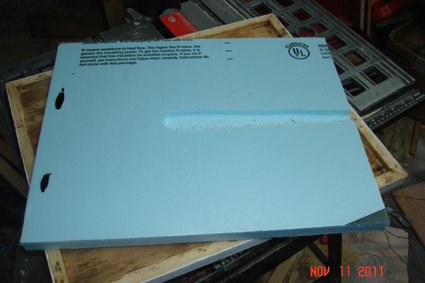
The track cut in the foam, lined up with the inner cover hole and edge vent hole allows warm moist air to escape when the foam is laid into place.
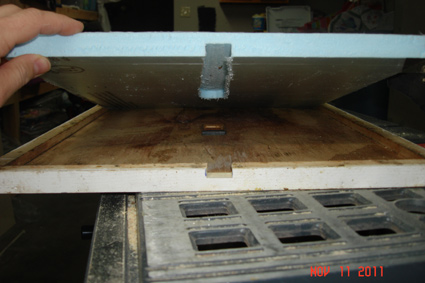
To double check my handy work, I lay the foam down into place, and make sure the holes line up and provide an air escape.
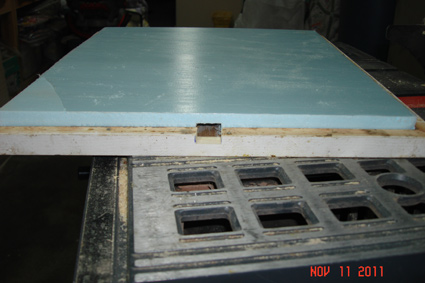
You can see the setup in place on top of the hive below.
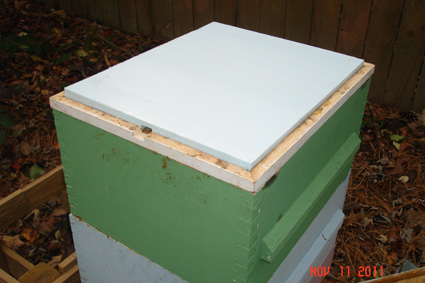
I then placed the bottle caps into place to keep the outer cover elevated, and added the outer telescoping cover, and with that, they're tucked into bed for the winter.
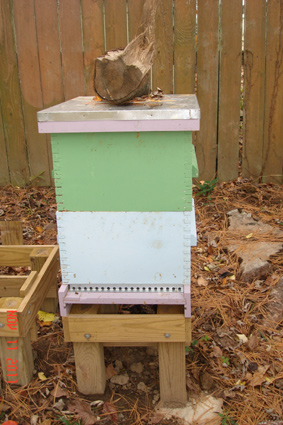
One common trick to reducing moisture in the hive is to place a popsicle stick or paint stirring stick on top of the inner cover towards the front of the hive so that the telescoping cover is propped up in the front.
This allows the warm moist air inside the hive a way out and should any build up and condense under the cover, because its raised higher in the front and lower in the back, any condensation would roll to the back of the cover and drip out behind the hive.
I happen to have a few beer bottle tops laying around, and liked the idea of gently pressing their rigid edge down into the wood causing them not to move, so I used them instead.
Another trick that's used to reduce moisture in the hive is to take 1/2 inch (or 3/4 inch) rigid insulation foam board and insulate the inner cover. The idea is that by insulating the inner cover, and preventing the cold winter air getting to the inner cover, warm air will not condense on the bottom side of it and rain down on the bees.

Most hardware stores sell this rigid foam in 4'x8' sections, most for as little as $13 a sheet. Take your inner cover and turn it flat side down and cut a piece of foam to fit inside the rim and press it down against the inner cover hole.
Then using a saw, Dremel tool or router, cut an approx 3/8th inch deep track that leads from the inner cover hole to the outside edge of the inner cover where the vent hole is as shown below.

The track cut in the foam, lined up with the inner cover hole and edge vent hole allows warm moist air to escape when the foam is laid into place.

To double check my handy work, I lay the foam down into place, and make sure the holes line up and provide an air escape.

You can see the setup in place on top of the hive below.

I then placed the bottle caps into place to keep the outer cover elevated, and added the outer telescoping cover, and with that, they're tucked into bed for the winter.

Comments For This Post: (8) | Post Your Comments! Hide The Comment Form